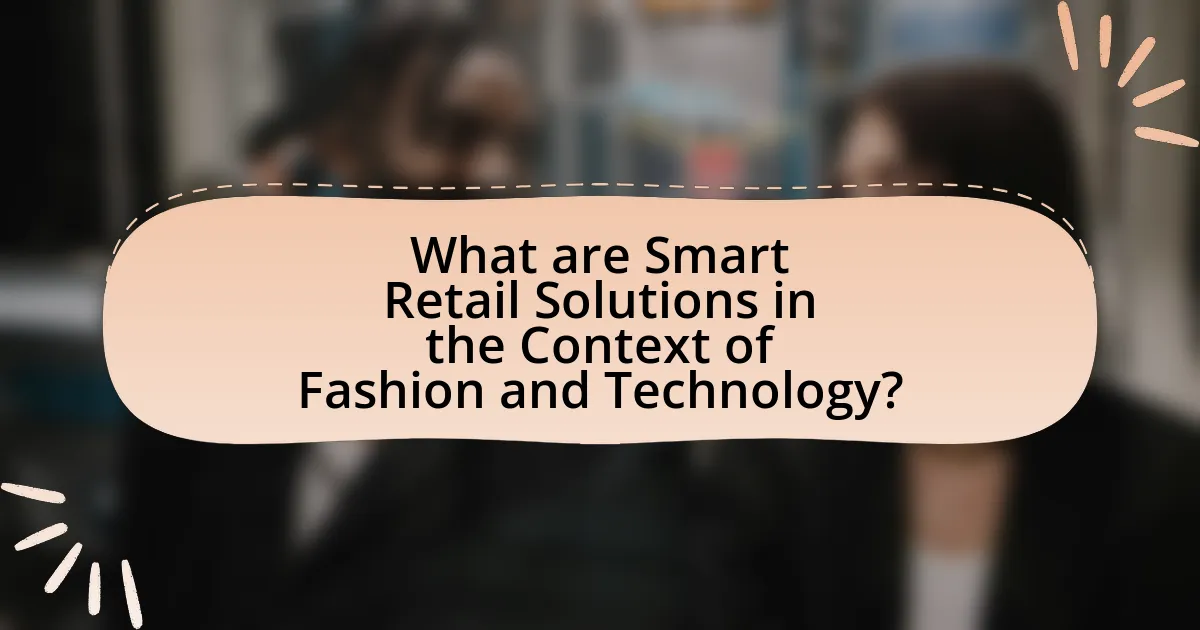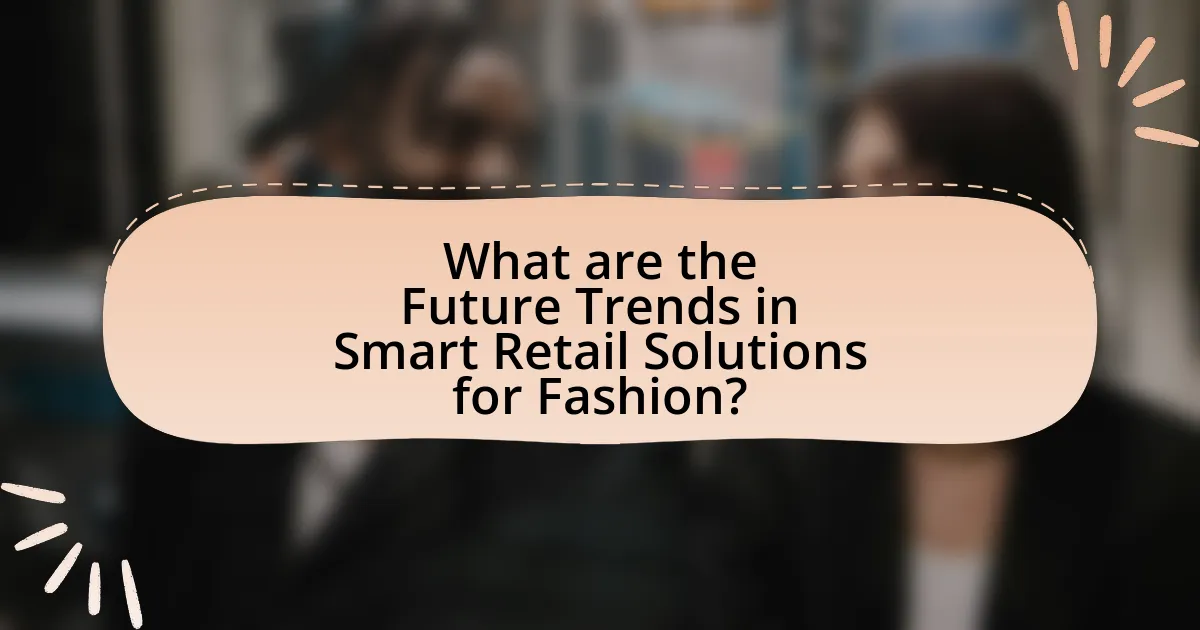Smart retail solutions represent the integration of advanced technologies within the fashion industry to enhance the shopping experience and streamline operations. This article explores how innovations such as artificial intelligence, augmented reality, and data analytics are transforming consumer engagement, inventory management, and personalized marketing strategies. It also addresses the challenges retailers face in adopting these technologies, including high costs and data privacy concerns, while highlighting best practices for successful implementation. Additionally, the article examines future trends and the potential impact of emerging technologies like blockchain on the fashion retail landscape.

What are Smart Retail Solutions in the Context of Fashion and Technology?
Smart retail solutions in the context of fashion and technology refer to innovative systems and tools that enhance the shopping experience through the integration of digital technologies. These solutions include features such as augmented reality for virtual try-ons, artificial intelligence for personalized recommendations, and data analytics for inventory management. For instance, a study by McKinsey & Company highlights that retailers using AI-driven analytics can improve inventory turnover by up to 30%. This demonstrates that smart retail solutions not only streamline operations but also significantly enhance customer engagement and satisfaction in the fashion industry.
How do Smart Retail Solutions integrate technology into the fashion industry?
Smart Retail Solutions integrate technology into the fashion industry by utilizing data analytics, artificial intelligence, and IoT devices to enhance customer experiences and streamline operations. For instance, retailers employ data analytics to understand consumer behavior, enabling personalized marketing strategies that increase sales. Artificial intelligence is used in inventory management to predict trends and optimize stock levels, reducing waste and improving efficiency. Additionally, IoT devices, such as smart mirrors and RFID tags, provide interactive shopping experiences and real-time inventory tracking, which enhances customer engagement and satisfaction. These technologies collectively transform traditional retail practices, making them more responsive to market demands and consumer preferences.
What types of technologies are commonly used in Smart Retail Solutions?
Smart retail solutions commonly utilize technologies such as artificial intelligence (AI), the Internet of Things (IoT), big data analytics, and augmented reality (AR). AI enhances customer experiences through personalized recommendations and chatbots, while IoT devices enable real-time inventory management and smart shelves. Big data analytics allows retailers to analyze consumer behavior and optimize pricing strategies. AR provides immersive shopping experiences, allowing customers to visualize products in their environment before purchase. These technologies collectively improve operational efficiency and customer engagement in the retail sector.
How do these technologies enhance the shopping experience?
Technologies enhance the shopping experience by providing personalized recommendations, improving inventory management, and facilitating seamless transactions. For instance, artificial intelligence algorithms analyze customer data to suggest products tailored to individual preferences, which can increase conversion rates by up to 30%. Additionally, smart inventory systems utilize real-time data to ensure product availability, reducing stockouts and improving customer satisfaction. Furthermore, mobile payment solutions streamline the checkout process, leading to shorter wait times and a more efficient shopping experience. These advancements collectively create a more engaging and convenient environment for consumers.
What challenges do retailers face when implementing Smart Retail Solutions?
Retailers face several challenges when implementing Smart Retail Solutions, including high initial costs, integration complexities, and data privacy concerns. High initial costs can deter retailers from adopting advanced technologies, as investments in hardware, software, and training can be substantial. Integration complexities arise when trying to merge new systems with existing infrastructure, often requiring significant time and technical expertise. Additionally, data privacy concerns are paramount, as retailers must navigate regulations like GDPR while ensuring customer data is protected, which can complicate the deployment of smart technologies. These challenges highlight the need for careful planning and resource allocation in the adoption of Smart Retail Solutions.
What are the common barriers to technology adoption in fashion retail?
Common barriers to technology adoption in fashion retail include high costs, lack of technical expertise, resistance to change, and integration challenges. High costs deter many retailers from investing in new technologies, as initial investments can be substantial. The lack of technical expertise within the workforce limits the ability to implement and utilize advanced technologies effectively. Resistance to change often stems from established practices and fear of disrupting existing operations. Additionally, integration challenges arise when new technologies must work seamlessly with legacy systems, complicating the adoption process. These barriers collectively hinder the advancement of technology in the fashion retail sector.
How can retailers overcome these challenges?
Retailers can overcome challenges by adopting advanced technology solutions that enhance customer experience and streamline operations. Implementing data analytics allows retailers to understand consumer behavior, optimize inventory management, and personalize marketing strategies. For instance, a study by McKinsey & Company found that retailers leveraging data analytics can increase their sales by 10-15% through targeted promotions and improved stock levels. Additionally, integrating omnichannel strategies ensures a seamless shopping experience across online and offline platforms, which is crucial as 73% of consumers use multiple channels during their shopping journey. By focusing on these technological advancements, retailers can effectively address the challenges posed by evolving consumer expectations and market dynamics.

How are Consumer Behaviors Influenced by Smart Retail Solutions?
Consumer behaviors are influenced by smart retail solutions through enhanced personalization, convenience, and engagement. Smart retail technologies, such as AI-driven recommendation systems and mobile payment options, allow retailers to tailor shopping experiences to individual preferences, leading to increased customer satisfaction and loyalty. For instance, a study by McKinsey & Company found that personalized experiences can lead to a 10-30% increase in sales. Additionally, smart retail solutions streamline the shopping process, reducing friction and encouraging impulse purchases. The integration of augmented reality in retail has also been shown to increase consumer engagement, with a report from Deloitte indicating that 40% of consumers are more likely to make a purchase after using AR features. These factors collectively shape consumer behaviors by making shopping more efficient and enjoyable.
What role does personalization play in Smart Retail Solutions?
Personalization plays a crucial role in Smart Retail Solutions by enhancing customer experience and driving sales. By leveraging data analytics and artificial intelligence, retailers can tailor product recommendations, marketing messages, and shopping experiences to individual preferences. For instance, a study by McKinsey & Company found that personalized experiences can lead to a 10-30% increase in revenue, as customers are more likely to engage with brands that understand their unique needs. This targeted approach not only improves customer satisfaction but also fosters brand loyalty, making personalization a key component of successful smart retail strategies.
How do data analytics contribute to personalized shopping experiences?
Data analytics significantly enhance personalized shopping experiences by enabling retailers to analyze customer behavior and preferences. Through the collection and examination of data such as purchase history, browsing patterns, and demographic information, retailers can tailor product recommendations and marketing strategies to individual consumers. For instance, a study by McKinsey & Company found that personalized recommendations can increase sales by 10 to 30 percent, demonstrating the effectiveness of data-driven insights in enhancing customer engagement and satisfaction. By leveraging these analytics, retailers can create a more relevant and customized shopping journey, ultimately leading to improved customer loyalty and higher conversion rates.
What are the benefits of personalized marketing in fashion retail?
Personalized marketing in fashion retail enhances customer engagement and increases sales by tailoring experiences to individual preferences. This approach allows retailers to deliver targeted recommendations, improving the likelihood of purchase; for instance, studies show that personalized emails can lead to a 29% increase in open rates and a 41% increase in click-through rates. Additionally, personalized marketing fosters customer loyalty, as consumers are more likely to return to brands that understand their unique tastes and shopping behaviors. According to a report by McKinsey, personalization can drive revenue growth by 10% to 30% in fashion retail, demonstrating its significant impact on business performance.
How do Smart Retail Solutions impact customer engagement?
Smart retail solutions significantly enhance customer engagement by utilizing data analytics, personalized marketing, and interactive technologies. These solutions enable retailers to analyze customer behavior and preferences, allowing for tailored shopping experiences that resonate with individual consumers. For instance, a study by McKinsey & Company found that personalized recommendations can increase sales by 10 to 30 percent, demonstrating the effectiveness of targeted engagement strategies. Additionally, technologies such as augmented reality and mobile apps create immersive shopping experiences, further driving customer interaction and satisfaction.
What technologies enhance customer interaction in stores?
Technologies that enhance customer interaction in stores include mobile apps, interactive kiosks, augmented reality (AR), and artificial intelligence (AI) systems. Mobile apps facilitate personalized shopping experiences by offering features like product recommendations and loyalty rewards, which can increase customer engagement. Interactive kiosks provide customers with information and self-service options, improving the shopping experience by reducing wait times. Augmented reality allows customers to visualize products in their own environment, enhancing decision-making and satisfaction. AI systems analyze customer data to tailor marketing strategies and improve service efficiency, leading to a more personalized shopping experience. These technologies collectively contribute to a more engaging and efficient retail environment, as evidenced by studies showing that stores implementing such technologies see increased customer satisfaction and sales.
How does omnichannel retailing improve customer satisfaction?
Omnichannel retailing improves customer satisfaction by providing a seamless shopping experience across multiple channels. This approach allows customers to interact with a brand through various touchpoints, such as online stores, physical locations, and mobile apps, ensuring convenience and flexibility. Research by Harvard Business Review indicates that customers who engage with multiple channels spend 10% more in-store than those who only use one channel. Additionally, omnichannel strategies enhance personalization, as retailers can gather data from different interactions to tailor offers and recommendations, leading to a more satisfying shopping experience.

What are the Future Trends in Smart Retail Solutions for Fashion?
Future trends in smart retail solutions for fashion include the integration of artificial intelligence, augmented reality, and personalized shopping experiences. Artificial intelligence is increasingly used for inventory management and customer insights, enabling retailers to predict trends and optimize stock levels. Augmented reality enhances the shopping experience by allowing customers to virtually try on clothing, which can lead to higher conversion rates. Additionally, personalized shopping experiences driven by data analytics are becoming essential, as they cater to individual customer preferences and improve customer satisfaction. According to a report by McKinsey, 75% of consumers expect personalized experiences, highlighting the importance of these trends in shaping the future of fashion retail.
How is artificial intelligence shaping the future of fashion retail?
Artificial intelligence is transforming the future of fashion retail by enhancing personalization, optimizing inventory management, and improving customer experience. AI algorithms analyze consumer data to provide tailored recommendations, which can increase sales by up to 30%, as reported by McKinsey & Company. Additionally, AI-driven tools help retailers forecast demand more accurately, reducing excess inventory by approximately 20%, according to a study by the Boston Consulting Group. Furthermore, AI chatbots and virtual assistants streamline customer service, leading to higher satisfaction rates and increased customer loyalty. These advancements illustrate how AI is not only reshaping operational efficiencies but also redefining consumer engagement in the fashion retail sector.
What are the potential applications of AI in inventory management?
AI can significantly enhance inventory management through applications such as demand forecasting, automated stock replenishment, and real-time inventory tracking. Demand forecasting utilizes machine learning algorithms to analyze historical sales data and predict future inventory needs, leading to optimized stock levels and reduced overstock or stockouts. Automated stock replenishment systems leverage AI to trigger orders based on predefined thresholds and sales trends, ensuring that inventory is maintained efficiently. Real-time inventory tracking employs AI-driven technologies like RFID and IoT sensors to provide accurate visibility into stock levels, enabling businesses to make informed decisions quickly. These applications collectively improve operational efficiency, reduce costs, and enhance customer satisfaction in inventory management.
How can AI improve customer service in fashion retail?
AI can improve customer service in fashion retail by providing personalized shopping experiences through data analysis and machine learning algorithms. These technologies analyze customer preferences, purchase history, and browsing behavior to recommend products tailored to individual tastes, enhancing customer satisfaction and engagement. For instance, a study by McKinsey & Company found that personalized recommendations can increase sales by 10 to 30%. Additionally, AI-powered chatbots can offer 24/7 customer support, addressing inquiries and resolving issues promptly, which further streamlines the shopping experience. This combination of personalization and efficient support demonstrates how AI can significantly enhance customer service in the fashion retail sector.
What emerging technologies are expected to influence Smart Retail Solutions?
Emerging technologies expected to influence Smart Retail Solutions include artificial intelligence (AI), the Internet of Things (IoT), augmented reality (AR), and blockchain. AI enhances customer experience through personalized recommendations and predictive analytics, with a report from McKinsey indicating that AI can increase retail profitability by 60%. IoT connects devices and systems, enabling real-time inventory management and customer insights, as evidenced by a study from Deloitte showing that IoT can reduce operational costs by up to 30%. AR provides immersive shopping experiences, with a survey by Retail Perceptions revealing that 61% of consumers prefer retailers that offer AR experiences. Blockchain ensures transparency and security in transactions, with research from IBM highlighting that 33% of consumers are willing to pay a premium for products with verified origins.
How will augmented reality change the shopping experience?
Augmented reality (AR) will significantly enhance the shopping experience by allowing customers to visualize products in their real-world environment before making a purchase. This technology enables users to try on clothing, accessories, or makeup virtually, thereby increasing confidence in their buying decisions. For instance, a study by Deloitte found that 40% of consumers are willing to pay more for a product if they can experience it through AR. Additionally, AR can provide interactive product information, improving customer engagement and satisfaction. This shift towards immersive shopping experiences is supported by the growing adoption of AR applications in retail, with companies like IKEA and Sephora successfully implementing AR solutions to boost sales and customer loyalty.
What is the potential of blockchain in fashion retail?
The potential of blockchain in fashion retail lies in its ability to enhance transparency, traceability, and authenticity of products. By utilizing blockchain technology, fashion retailers can create immutable records of a product’s journey from production to sale, allowing consumers to verify the origin and authenticity of items. For instance, brands like Everledger have successfully implemented blockchain to track the provenance of luxury goods, ensuring that consumers can confirm the legitimacy of their purchases. This increased transparency can reduce counterfeiting, improve supply chain efficiency, and foster consumer trust, ultimately transforming the fashion retail landscape.
What best practices should retailers follow when adopting Smart Retail Solutions?
Retailers should prioritize customer experience, data integration, and staff training when adopting Smart Retail Solutions. Enhancing customer experience involves utilizing technology to personalize shopping, such as through AI-driven recommendations, which can increase customer satisfaction and loyalty. Data integration is crucial as it allows retailers to consolidate information from various sources, enabling better inventory management and targeted marketing strategies. Staff training ensures that employees are equipped to use new technologies effectively, which can lead to improved operational efficiency and customer service. According to a report by McKinsey, companies that invest in employee training see a 24% increase in productivity, highlighting the importance of this practice in the successful implementation of Smart Retail Solutions.
How can retailers effectively train staff on new technologies?
Retailers can effectively train staff on new technologies by implementing a structured training program that includes hands-on workshops, online tutorials, and continuous support. This approach allows employees to engage with the technology directly, enhancing their understanding and retention of information. Research indicates that experiential learning, such as simulations and role-playing, significantly improves skill acquisition and confidence in using new tools. For instance, a study by the Association for Talent Development found that organizations with comprehensive training programs see a 218% higher income per employee than those without. This evidence supports the effectiveness of a multifaceted training strategy in equipping retail staff with the necessary skills to adapt to technological advancements.
What strategies can retailers use to measure the success of Smart Retail Solutions?
Retailers can measure the success of Smart Retail Solutions by utilizing key performance indicators (KPIs) such as sales growth, customer engagement metrics, and inventory turnover rates. Sales growth indicates the effectiveness of smart solutions in driving revenue, while customer engagement metrics, including foot traffic and online interactions, assess how well these technologies enhance the shopping experience. Additionally, monitoring inventory turnover rates helps retailers evaluate the efficiency of stock management facilitated by smart solutions. According to a report by McKinsey, retailers that implement data-driven strategies can see a 10-20% increase in sales, demonstrating the tangible benefits of measuring these KPIs in relation to smart retail technologies.




